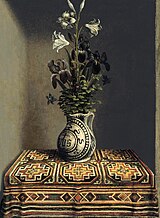
Back البسط الشرقية في عصر النهضة Arabic Orientteppiche in der Renaissancemalerei German Alfombras orientales en la pintura renacentista Spanish Fondation Custodia French Tappeti orientali nei dipinti del Rinascimento Italian
Left image: A "Bellini type" Islamic prayer rug, seen from the top, at the feet of the Virgin Mary, in Gentile Bellini's Madonna and Child Enthroned, late 15th century.
Right image: Prayer rug, Anatolia, late 15th to early 16th century, with "re-entrant" keyhole motif.
Right image: Prayer rug, Anatolia, late 15th to early 16th century, with "re-entrant" keyhole motif.
Left image: Hans Memling's Still Life with a Jug with Flowers, late 15th century.
Right image: Mugan carpet, Karabakh school,[1][2] late 14th to early 15th century, Azerbaijan Carpet Museum[1]
Right image: Mugan carpet, Karabakh school,[1][2] late 14th to early 15th century, Azerbaijan Carpet Museum[1]
Carpets of Middle-Eastern origin, either from Anatolia, Persia, Armenia, Levant, the Mamluk state of Egypt or Northern Africa, were used as decorative features in Western European paintings from the 14th century onwards. More depictions of Oriental carpets in Renaissance painting survive than actual carpets contemporary with these paintings. Few Middle-Eastern carpets produced before the 17th century remain, though the number of these known has increased in recent decades. Therefore, comparative art-historical research has from its onset in the late 19th century relied on carpets represented in datable European paintings.
- ^ a b Лятиф Керимов. Азербайджанский ковёр. Том III. VI. Карабахская школа. Б) Джебраилская группа. Б.: «Гянджлик», 1983, рис.121
- ^ Azerbaijani carpets: Karabakh group, Azerbaijan Carpet Museum, page 124-125 Accessed: 28. 07. 2013
© MMXXIII Rich X Search. We shall prevail. All rights reserved. Rich X Search



